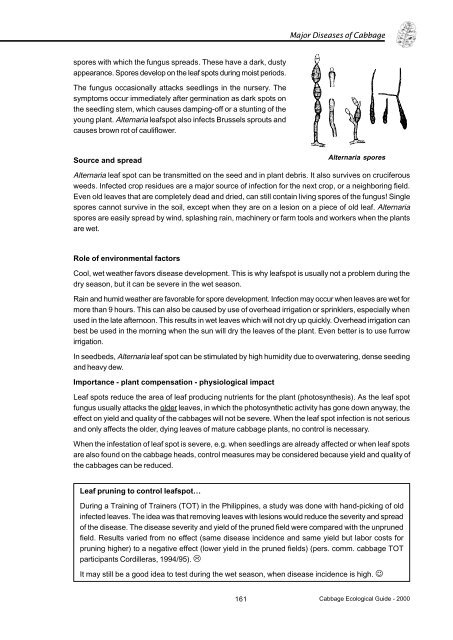Cabbage Integrated Pest Management : An Ecological Guide.
Cabbage Integrated Pest Management : An Ecological Guide.
Cabbage Integrated Pest Management : An Ecological Guide.
Create successful ePaper yourself
Turn your PDF publications into a flip-book with our unique Google optimized e-Paper software.
Major Diseases of <strong>Cabbage</strong>spores with which the fungus spreads. These have a dark, dustyappearance. Spores develop on the leaf spots during moist periods.The fungus occasionally attacks seedlings in the nursery. Thesymptoms occur immediately after germination as dark spots onthe seedling stem, which causes damping-off or a stunting of theyoung plant. Alternaria leafspot also infects Brussels sprouts andcauses brown rot of cauliflower.Source and spreadAlternaria sporesAlternaria leaf spot can be transmitted on the seed and in plant debris. It also survives on cruciferousweeds. Infected crop residues are a major source of infection for the next crop, or a neighboring field.Even old leaves that are completely dead and dried, can still contain living spores of the fungus! Singlespores cannot survive in the soil, except when they are on a lesion on a piece of old leaf. Alternariaspores are easily spread by wind, splashing rain, machinery or farm tools and workers when the plantsare wet.Role of environmental factorsCool, wet weather favors disease development. This is why leafspot is usually not a problem during thedry season, but it can be severe in the wet season.Rain and humid weather are favorable for spore development. Infection may occur when leaves are wet formore than 9 hours. This can also be caused by use of overhead irrigation or sprinklers, especially whenused in the late afternoon. This results in wet leaves which will not dry up quickly. Overhead irrigation canbest be used in the morning when the sun will dry the leaves of the plant. Even better is to use furrowirrigation.In seedbeds, Alternaria leaf spot can be stimulated by high humidity due to overwatering, dense seedingand heavy dew.Importance - plant compensation - physiological impactLeaf spots reduce the area of leaf producing nutrients for the plant (photosynthesis). As the leaf spotfungus usually attacks the older leaves, in which the photosynthetic activity has gone down anyway, theeffect on yield and quality of the cabbages will not be severe. When the leaf spot infection is not seriousand only affects the older, dying leaves of mature cabbage plants, no control is necessary.When the infestation of leaf spot is severe, e.g. when seedlings are already affected or when leaf spotsare also found on the cabbage heads, control measures may be considered because yield and quality ofthe cabbages can be reduced.Leaf pruning to control leafspot…During a Training of Trainers (TOT) in the Philippines, a study was done with hand-picking of oldinfected leaves. The idea was that removing leaves with lesions would reduce the severity and spreadof the disease. The disease severity and yield of the pruned field were compared with the unprunedfield. Results varied from no effect (same disease incidence and same yield but labor costs forpruning higher) to a negative effect (lower yield in the pruned fields) (pers. comm. cabbage TOTparticipants Cordilleras, 1994/95). LIt may still be a good idea to test during the wet season, when disease incidence is high. J161 <strong>Cabbage</strong> <strong>Ecological</strong> <strong>Guide</strong> - 2000




![Section 4 [ PDF file, 252 KB] - The Field Alliance](https://img.yumpu.com/51387260/1/158x260/section-4-pdf-file-252-kb-the-field-alliance.jpg?quality=85)











